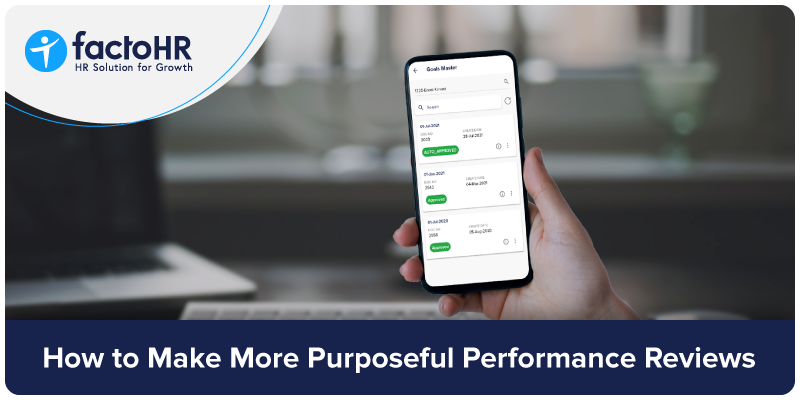How to Make More Purposeful Performance Reviews

Table of Contents
It is commonly believed that what can’t be measured can’t be improved. Fortunately, the performance of your employees can be measured and reviewed, and thus be improved.
Most companies have an annual review of how their employees performed during the past year. This yearly cycle coincides with financial year closure and beginning of the new FY. This arrangement allows organisations to a) give out bonuses or performance based incentives and b) plan their budgets based on the new costs as a result of salary hikes. While an annual review makes sense from a financial point of view, it does not provide any opportunity to course-correct the employees during the year. The lack of course-correction impacts the performance of both, the employee’s and the organisation’s.
Continuous Feedback – A Preferred Approach
Companies are now shifting to continuous performance management, where employees discuss their performance with their managers more frequently. The frequency is determined by mutual agreement and requirement of the individual employee. The advantage of this approach is that there are no surprises when the employee and manager review performance as part of the year end cycle.
A continuous dialogue between employees and their managers with respect to performance goals and objectives that were mutually agreed at the start of the cycle has shown to be highly beneficial . Managers can then do their best to ensure the employees meet their goals. They can continuously monitor the employee’s work and provide assistance as needed- whether it is coaching, training, new tools or anything else that is required to complete the work and achieve the objectives. As you know, employee objectives are a trickled down version of the company’s goals. Only when all the employees are successful would the organisation be successful.
Performance management should be as objective as possible and not depend on the judgement or biases (if any) of the manager.

Some Guidelines for a Successful Framework
By drawing up a good framework, organisations can help employees realise higher levels of their performance at work. Here are some important guidelines to make these reviews more purposeful and meaningful:
1. Create a performance management plan
A good plan is what most successful outcomes start as. So, build a detailed plan consulting all stakeholders of the process.
- When organisational goals are translated into pieces of work which need to be performed by individuals to accomplish that objective, ensure there is clarity in the statement of work.
- Define clearly for each work packet, – what exceeding, meeting and not meeting expectations look like.
- Implement a risk and reward system that is fair and motivating to the employees.
- Consider implementing a 360 degree review process.
- Define ratings scales for measuring work output both in terms of what is accomplished and how it was done. There are many instances where people have achieved what they set out to do, but by bending organisation rules. These types of behaviours can cause damage to the organisation’s reputation. So, many companies now measure both quantitative and qualitative outputs.
- Introduce the performance management plan, methodology used and ratings system to the new hires as part of their induction. Managers should discuss the goals as soon as the new hires start on their job.
2. SMART goals
When work is assigned to the employee, the manager needs to provide clear expectations of the outcome. Most companies insist that the goals should be SMART:
- Specific – answering questions starting what, who and how will make the goal specific. What needs to be accomplished, who needs to do what and which specific steps or method needs to be used to achieve the objective
- Measurable – the expected outcome should be quantifiable and measurable. This helps in avoiding setting up vague and subjective goals
- Achievable – the goals should be achievable in the defined time frame and available resources. Setting up lofty goals may sound ambitious but will result in underachievement and affect the morale of the employee
- Relevant – goals should be relevant to the role the employee has signed up to do as well as be relevant to the objectives of the company
- Time-bound – Alway have a timeframe for any goal. Open ended goals with no clear time-line are not measurable nor can their progress be tracked.
For each of the goals, the rating scale agreed during planning should be applicable without any ambiguity. If you are wondering how to write/create SMART goals, Atlassian spells it all for you.

3. Continuous review and 1-2-1s
It may sound daunting at first, but if planned correctly, both manager and employee can spend enough time reviewing progress on the agreed goals, without needing to micromanage. It is a planned engagement between the employee and manager where they can review what was planned for in the last such meeting. Like for any meeting, it is important to be prepared. The outcome of the meeting and agreed observations should be documented for future reference.
Either party does not have to wait till the next scheduled meeting if there is a need to exchange ideas or give or take feedback on performance as it helps course correction and better outcome.
All of the recorded information could be summarised for the year end review. Since the manager and employee have been discussing throughout the period, they both can quickly agree on the ratings and plan for the future.
4. Have a good performance management system in place
Many organisations use a performance management software (PMS for short). You should too. The advantages of having a PMS are that
- It provides a place where all the documentation can happen
- Employees can do self-service and enter the goals/objectives that they have agreed with their managers
- Employees can update and report progress on goals and milestones achieved on a periodic basis and not miss out any details
- Managers can review goals and progress on a regular basis and provide their comments and feedback
- If the organisation has a rewards and recognition policy and is actively looking to encourage their best performers, PMS could be a great source of information for managers to quickly nominate staff from their teams
- PMS is a great source for identifying skill gaps and feeding that to the training department who in turn can arrange required training sessions for the target employees
- Lastly, the year end performance ratings and the resulting salary hikes and bonuses can be fed to the payroll system for accurate disbursements
Choose a PMS that –
- Is easy to use with an intuitive interface. Employees and managers should not be spending a lot of time figuring out how to work the system. They should be focused on inputting goals and reviewing them
- Is customisable and can incorporate rating scales and weightages to each goal. This will ensure any future change in approach to ratings can be implemented
- Has the flexibility to adapt to new ways of working or new methods of performance evaluation. With “work from home”, “part time” and “job sharing” getting popular, it should allow the managers and employees to interact both synchronously and asynchronously
- Can integrate with existing systems and provide a seamless experience. For example, as discussed earlier, skill gaps should feed into training modules and performance ratings into the payroll
- Provides analytics and reporting facilities so that management can take a view of the organisation at every level and take actions as necessary

Conclusion
When done in a structured way with the intent of making your employees successful, performance reviews help both the employees and organisation immensely. On the other hand, if you get it wrong, it adversely impacts the growth of the organisation as well as the employees.
Grow your business with factoHR today
Focus on the significant decision-making tasks, transfer all your common repetitive HR tasks to factoHR and see the things falling into their place.

© 2025 Copyright factoHR


